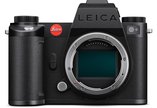
-
JOIN OUR WAITLIST
You've been added. Thank You!
×Leica SL3



4 Day Rental Price:
$309.00
The Leica SL3 is the high-end camera and lens manufacturer’s third-generation full-frame mirrorless camera, and a significant update to the SL2 and SL2-S. Key features include:
-
60MP full-frame CMOS sensor; Maestro IV processor
-
60MP, 36MP, or 18MP stills; 8GB of buffer memory
-
Revised autofocus system, user interface, and controls
-
0.73x-magnification EVF; 3.2-inch tilting rear touchscreen
What’s Changed? The Leica SL3 features a number of improvements over its predecessors, the SL2 and SL2-S, many of which are borrowed directly from the M11. Chief among the SL3’s updates are the 60MP full-frame CMOS sensor and Maestro IV image processor, which combine with 8GB of buffer memory to produce ultra-sharp images. The SL3 can output RAW or JPEG files in 60MP, 36MP, or 18MP resolution, and it has a broad 50-100,000 ISO range. The revised autofocus system now includes phase-detection elements and a subject-recognition feature. On the video front, the SL3 captures internal 8K 30p footage, where its predecessors topped out at 5K 30p and UHD 4K 60p, respectively. There are also refined controls, a fully redesigned user interface, a higher-capacity battery, and a new, more lightweight build.
60MP CMOS Sensor and Maestro IV Processor. The Leica SL3’s combination of a back-illuminated, full-frame 60MP CMOS sensor; a new Maestro IV image processor; and 8GB of buffer memory produces fast capture, operation, and startup speeds, and an impressive dynamic range that takes full advantage of the best of the Leica L-mount lenses. You get greatly improved sensitivity from ISO 50-100,000 for stellar performance in a range of lighting conditions. That said, the continuous shooting rate tops out at 4 fps with autofocus and full 14-bit sensor readout, 5 fps in 12-bit mode, and 12 fps if you can do without between-shot focus and exposure updates, which all seems a little strange given the SL3’s power.
Enhanced Imaging Capabilities. The SL3 carries over the M11’s unique pixel-binning process, which lets photographers select 60MP, 26MP, or 18MP output for their RAW, JPEG, and DNG files, with each resolution using the full sensor area and providing vibrant 14-bit color. Because Triple Resolution Technology uses pixel-binning instead of cropping, even lower resolutions have an impressive dynamic range and low noise levels. The 60MP setting gives you 14 stops of dynamic range and the highest resolution, the 36MP setting gives you 15 stops of dynamic range and the best noise-resolution balance, and the 18MP setting also gives you 15 stops of dynamic range with the lowest noise levels.
Speedy Shutters. An electronic shutter function lets you shoot at speeds up to 1/16000 sec, letting you work with faster f/0.95 lenses without an ND filter. A mechanical shutter gives you shutter-speed support up to 1/8000 sec and flash sync at 1/200 sec.
Sensor-Shift Image Stabilization. The SL3’s five-axis image-stabilization system provides up to five stops of shake reduction to keep things ultra-sharp even when you’re shooting hand-held or in less-than-ideal lighting.
Video Powerhouse. The SL3 is capable of internally capturing 10-bit UHD and DCI 8K 30p 4:2:0 footage to a CFexpress card in 1.89:1 or 16:9 aspect ratios using the H.265 codec, with storage space and battery life as its only limitations. It can also capture ProRes 1080p with no time limits, UHD and DCI 4K 30p taken from the 8K capture, and line-skipped 4K 60p from the same area of the sensor. You can use the dedicated Hybrid Log Gamma Photo Style mode and L-Log gamma profile to expand highlight and shadow details for greater flexibility when color grading. If you’re shooting in L-Log or HLG modes or simultaneously recording to a card, you can get 4K footage at up to 10-bit 4:2:2 through the HDMI port. If you’re not using one of those modes or recording to a card, then HDMI output is 8-bit UHD 8K 4:2:0.
Hybrid Autofocus System. The SL3’s hybrid autofocus system incorporates Phase Detection, Contrast Detection, and Object Detection for optimal performance in just about any shooting situation you throw at it, even capturing razor-sharp images of fast-moving subjects in low light. Intelligent subject recognition can be set to track humans by their eyes, faces, and bodies, and it can also track a range of animals, including birds.
Legendary Lensing. The Leica L-mount system offers users an incredible amount of flexibility when it comes to lensing. The native full-frame SL-series glass benefits from electronic communication for fast autofocus, electronic aperture control, and optical image stabilization. While this camera is natively compatible with L-mount lenses, it can also support Leica M, S, R, and TL lenses with the right adapters. Please note that TL lenses will only cover the APS-C/Super 35mm sensor area.
Screens to Spare. The rear 3.2-inch, 2.3m-dot rear touchscreen LCD gives you a large means by which to shoot in live view and review image playback, while also giving you immediate access to its revised, more intuitive graphical user interface. On top of that, it’s bright enough to be fully visible in sunlight and other bright conditions. The 5.76m-dot EyeRes OLED electronic viewfinder combines 0.8x magnification, 100% coverage, and a 120 fps refresh rate to give you a beautiful view. A small black-and-white LCD on top of the camera allows you to quickly check and change your current settings without having to use the rear screen or peek into the viewfinder.
Re-Make/Re-Model. Compared to its predecessors, the SL3’s body is more compact and lightweight, and its control layout has been revised to be even more intuitive. A third command dial, which controls ISO, has been added to the left of the viewfinder, while the two main command dials to the right of the viewfinder control exposure, shutter speed, and aperture. Leica has also moved the Play, Fn, and Menu keys to the right-hand side of the rear LCD so that they won’t be obscured when you tilt the screen. You get a USB Type-C port for fast file transfer and high-speed in-camera battery charging, an HDMI Type-A port that’s great for video, and 3.5mm mic and headphone jacks for pro-grade audio recording. And, of course, the camera body has the durable, weather-resistant magnesium and aluminum build that you’d expect from Leica.
Power and Memory. The SL3 uses the BP-SCL6 battery, which is rated at 320 shots per charge, or roughly 1350 shots per charge if you only use the optical viewfinder. There are two memory-card slots—one CFexpress Type B, the other UHS-II SD/SDHC/SDXC—to give you flexible file-storage options.
Connection Machine. You can use Wi-Fi or Bluetooth in conjunction with the Leica FOTOS app to share images directly to linked iOS devices, to remotely adjust camera options and control the shutter, and use geotagging on your shots. You can also use the USB Type-C port and the separately available Leica FOTOS cable to connect this camera to an iPhone for file management and sharing via the FOTOS app.
Q & A
- Does this rental include a lens?
-
This rental doesn’t include a lens, but you can find some options here.
-
- Does this camera work with non-Leica lenses?
-
Yeah! You can use any brand of L-mount lens with this camera body.
-
| Brand |
Leica |
| Camera Type |
Mirrorless |
| Environmental |
Operating Temperature
|
| Exposure Control |
Shutter Type
|
| Flash |
Built-In Flash/Light
|
| Focus |
Focus Type
|
| General |
Battery Type
|
| Imaging |
Sensor Resolution
|
| Interface |
Media/Memory Card Slot
|
| Item Type |
Camera |
| Mfr. Model Number |
10607 |
| Monitor |
Display Size
|
| Mount |
L Mount |
| Sensor Size |
Full Frame |
| Still Image Capture |
Image Sizes – 3:2 DNG
|
| Video Capture |
Internal Recording Modes – H.265 Long GOP 4:2:0 8/10-Bit
|
| Viewfinder |
Type
|

































